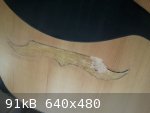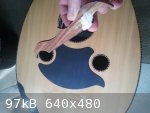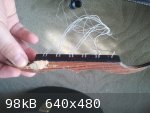| Pages:
1
2 |
naddad
Oud Maniac
   
Posts: 87
Registered: 6-14-2009
Member Is Offline
Mood: No Mood
|
|
Oud bridge snapped off, advice on glue
Hello,
My oud bridge came off, and I wasn't even playing it (it was resting in a temperature controlled room, at 22 C).
I think I should be able to glue it back, but would like your advice on which glue I should use.
Thanks.



|
|
|
Edward Powell
Oud Junkie
    
Posts: 1212
Registered: 1-20-2008
Member Is Offline
Mood: g'oud
|
|
if you want it to definitely stay on - and never come off again, then use some gel form super glue. Just clean up all the old glue and make sure the
bridge sits flat and flush... then apply the gel super glue to one or both surfaces, then press in place - keep pressing down quite hard for 10
minutes to be sure....
|
|
|
Oudbedis
Oud Addict
  
Posts: 34
Registered: 8-6-2012
Location: Tunisia
Member Is Offline
|
|
I really do not know weather glue is the right solution for fixing your Oud Bridge or not.
As you know , the wood of the face is the thinnest wood in the Oud , super glue may damage it , as fixing it in a wrong way as well , considering
that such operation requires a high precision , so that it matches perpendicularly stings .
Personally , I would ask a oud repairer for advice .
Bedis
|
|
|
Edward Powell
Oud Junkie
    
Posts: 1212
Registered: 1-20-2008
Member Is Offline
Mood: g'oud
|
|
super glue may damage it??? do you realise that in istanbul most of the best luthiers there use super glue extensively in their oud making - gluing
bridges, necks, purfling, pegboxes, and many other parts with super glue. You might feel more comfortable with the name CA glue. In turkey they call
it "japon". This glue does not damage wood at all... rather it fills the pore permanently and enhances the wood - however that problem with CA glue is
that you can not reverse it... if you make a mistake you are stuck! It is permanent.
turkish luthiers also make extensive use of contact cement! I have heard prominent guitar and violin makers say that contact cement has NO place in
luthiery...
Strangely, in my time in istanbul i almost never saw any luthier use white (or yellow) wood glue, which is unquestionably the most common glue among
guitar makers.
If you are not confident in gluing the bridge then take it to a luthier.
|
|
|
BaniYazid
Oud Junkie
    
Posts: 225
Registered: 8-20-2010
Location: France
Member Is Offline
|
|
Hello,
I glued back a bridge with Titebond Original two years ago, and it's still ok.
In your case, make sure to gently remove the old glue, you may degrease the bridge before applying the glue (depend on the wood, yours seems to be
rosewood). You'll need special clamps to maintain the bridge in place.
You can check perpendicularity to the centre line of the soundboard and the neck prior to do the job, with a long ruler and a square.
good luck
|
|
|
naddad
Oud Maniac
   
Posts: 87
Registered: 6-14-2009
Member Is Offline
Mood: No Mood
|
|
Thanks
How do I remove the old glue?
|
|
|
jdowning
Oud Junkie
    
Posts: 3485
Registered: 8-2-2006
Location: Ontario, Canada
Member Is Offline
Mood: No Mood
|
|
Hi Edward - where is contact cement used extensively on modern Turkish ouds? Just curious.
|
|
|
fernandraynaud
Oud Junkie
    
Posts: 1865
Registered: 7-25-2009
Location: San Francisco, California
Member Is Offline
Mood: m'Oudy
|
|
I dunno, it looks to me like removing the old glue could be a nightmare job. It looks like they didn't clamp the bridge very well. And there's that
wood chip in the one place where there was pressure.
I'd hazard that Edward's approach makes sense. Test the old glue layer, see if it's hide glue that's removable with warm water. If it is, get it off.
If it's some sort of plastic glue that won't come off that way, or with a solvent, it will probably hold, so you could just clean with some alcohol,
put the CA glue on both sides, get it in the chip area too so the chip bonds in place. No problem lining it up then. You probably won't need a clamp
if you can apply pressure from above and inside the sound hole for 10 minutes.
|
|
|
naddad
Oud Maniac
   
Posts: 87
Registered: 6-14-2009
Member Is Offline
Mood: No Mood
|
|
thank you all, I'll try and see what happens.
|
|
|
Dr. Oud
Oud Junkie
    
Posts: 1370
Registered: 12-18-2002
Location: Sacramento, CA, USA
Member Is Offline
Mood: better than before
|
|
If there is a residue of titebond, nothing much will stick, including more titebond. Most glues will soften with heat, so you can use a heat gun on
low or a hair dryer on high, carefully now, (do not overcook the face!) then scrape off the softened glue with a putty knife. Continue with moderate
heat and rub off the remaining glue with steel wool, only use fine grade, 00 or finer, I like 0000. Cyanoacrylate (japon, super glue) does have a
solvent that will soften it. The joint is most important to get a good fit - lap sand the bridge - hold a piece of 60 -80 grit garnet sandpaper on the
face, grit side up and rub the bridge back and forth in the direction of the neck, only a little way and only a little pressure, let the grit do the
work.
|
|
|
spyros mesogeia
Oud Junkie
    
Posts: 896
Registered: 9-10-2003
Location: WASHINGTON DC
Member Is Offline
Mood: play my ouds
|
|
Tidebond ......
And everything that Dr Oud mentioned.
Good luck brother
|
|
|
Edward Powell
Oud Junkie
    
Posts: 1212
Registered: 1-20-2008
Member Is Offline
Mood: g'oud
|
|
HI John,
CC is used to glue on the pick guards, and it is used to pre-glue strips of veneering to make purflings... probably that is an exaggeration to
call this "extensively"  ...but it is always there in the workshops. They use
it a lot also for gluing sandpaper to small wood blocks and things like this. ...but it is always there in the workshops. They use
it a lot also for gluing sandpaper to small wood blocks and things like this.
But no question that high and low viscosity CA glues are used extensively on Turkish ouds.
I myself do use CC extensively on my prototype instruments... partly because I can not get gel CA glue where I am in large quantities cheaply, and I
love a glue that grips tight immediately... what I do is use CC glue to get a grip, and then run CA glue in later for a permanent bond. I have made
many oud backs this way, gluing the ribs together with CC glue and then running CA glue in there to "fix" it. I know this is a silly way to work -
very toxic and un-reversible, but on a fast made prototype it is expedient.
Personally I do really like to use CC for fingerboards... it holds tight and you need no special gluing rigs or clamps... and it does come off
easily with heat (the only bummer is that if you do need to remove the fingerboard then it is a chemical hassle to clean off the glue)
I am sure that if I would be building the same model of instrument again and again i would develop technique to be able to use safe, reversible,
non-toxic glues for everything, but when each instrument is very different, sometimes the chemical glues are more expedient.
|
|
|
Edward Powell
Oud Junkie
    
Posts: 1212
Registered: 1-20-2008
Member Is Offline
Mood: g'oud
|
|
without any question you MUST get rid of all old glue... and make sure you have a PERFECT fit before gluing.
3 problems with titebond:
1) plastic type glues do not cure to a brittle hardness so do not transfer sound as well
2) water based glues will not last as long and be vulnerable to humitidy
3) slow drying glues need very special clamps.
CA glue solves all these problems BUT - it is a one way ticket so only do this if you are really sure you know what you are doing 
|
|
|
jdowning
Oud Junkie
    
Posts: 3485
Registered: 8-2-2006
Location: Ontario, Canada
Member Is Offline
Mood: No Mood
|
|
Thanks Edward.
If you like a glue that grips tight immediately why not try good old fashioned hot hide glue - strong, fast setting, non toxic, reversible, shrinks
when it cures (to make a joint even tighter) and is relatively low in cost? Also, in its dry state it has an infinite shelf life. Requires use of a
hot iron to remelt the glue in order to make long joints like soundboard or rib joints - a technique akin to making a soft soldered joint in metal.
For rib joints the old way was to temporarily hold the joint together - step by step - with glue soaked paper strips scorched in place with a hot iron
(scorching of hide glue causes it to set instantly and at the same time remelts the underlying glue in the joint for a perfect fit). When the bowl is
complete, the paper pieces covering the bowl exterior (and temporarily reinforcing the bowl) are then scraped off as part of the finishing process.
For straightforward (but accurately made) simple joints like neck or bridge use high bloom strength hot hide glue that will gel within a matter of
seconds - the joint held together with hand pressure for a few minutes to be sure. Speed is of the essence in these cases. Forget about it, however,
if the joint surface has been previously contaminated with modern synthetic glues.
|
|
|
Edward Powell
Oud Junkie
    
Posts: 1212
Registered: 1-20-2008
Member Is Offline
Mood: g'oud
|
|
Hi John, yes your advice is very good and makes sense. This is the direction I intend to and am moving in.
What I realised is the my instrument building has been damaging my health primarily for two reasons:
1) chemicals
2) dust
Dust is the main problem and one of the ways I am solving it is to go back to more traditional methods... like keeping my hand tools really really
sharp and using them rather than sandpaper and sanding machines which are horrendous producers of dust.
I can see now that I can reduce my chemical exposure by getting myself off of the chemical glues and using more hide glues as you suggest.
One thing that really gives me a headache for days is shellak... I don't use methanol which is known to be toxic, but I use ethanol but still it
makes me very ill, this stuff. . . I wonder if there is a truly safe solvent for shellak? ...in the meantime I have been using waterbased varnish
but it is unsatisfactory.
|
|
|
jdowning
Oud Junkie
    
Posts: 3485
Registered: 8-2-2006
Location: Ontario, Canada
Member Is Offline
Mood: No Mood
|
|
Hi Edward - sorry to hear about your health problems associated with your instrument work.
The problem is once sensitised to synthetic or natural chemicals it is difficult to avoid recurring reaction on repeated exposure. I also find wood
dust to be a problem - especially oily woods like rosewood and cedar. I have a dust extraction unit rigged up to my bandsaw which helps and - like you
- avoid sanding except sometimes for final hand rubbing down of varnish finishes. Besides sanding of wood produces a rather inferior surface (clogged
wood pores) compared to use of a cabinet scraper that planes the surface to produce shavings.
Your observation about shellak solvents reminds me of an old 19th C recipe that makes shellac water soluble (using Borax if I remember correctly). The
application was for making ink but I now wonder if it might have an application as a wood finish. I will look it up again to see and report back in
another topic if it holds any promise. In the meantime everyone should avoid handling or breathing (not to mention drinking!) methanol (wood alcohol)
as it can be absorbed through the skin. One problem is that poisoned ethanol (Methylated Spirit) is not readily available in North America as it is
(or was) in Europe - sale of pure ethanol is, of course, restricted and very costly.
Sad that we have to suffer in the pursuit of our chosen craft.
|
|
|
fernandraynaud
Oud Junkie
    
Posts: 1865
Registered: 7-25-2009
Location: San Francisco, California
Member Is Offline
Mood: m'Oudy
|
|
Polish ethanol sold under the name "Spirytus" is 96% and not THAT expensive. I recently got a fifth bottle in San Francisco (under the counter in a
Polish deli) for about $17. Sure beats breathing methanol or petroleum distillates.
|
|
|
Edward Powell
Oud Junkie
    
Posts: 1212
Registered: 1-20-2008
Member Is Offline
Mood: g'oud
|
|
the shellak solvent I buy - i buy in Czech - and as far as i can understand the label, it says ETHANOL not METHANOL, but still, it gives me a headache
that can last for days! [i'd really hate to feel what actual methanol would do to me!]
but people say ethanol is OK 
|
|
|
Edward Powell
Oud Junkie
    
Posts: 1212
Registered: 1-20-2008
Member Is Offline
Mood: g'oud
|
|
John, can I ask you about your bandsaw - and perhaps some advice regarding getting a reasonable bandsaw capable of resawing up to 20cm wide
soundboards ACCURATELY?
I am considering building my own bandsaw, but that would take much time. . .
thanks
|
|
|
jdowning
Oud Junkie
    
Posts: 3485
Registered: 8-2-2006
Location: Ontario, Canada
Member Is Offline
Mood: No Mood
|
|
Off topic so apologies naddad. So briefly.
My bandsaw is a 1980's vintage American made 14" Rockwell - solid cast iron construction with 3/4 HP motor - a general workhorse used for all of my
woodworking projects not just instrument work. Maximum depth of cut is 6 inches but this can be increased to 12 inches with a riser block. The saw has
its irritating design faults but when properly set up can easily resaw softwood accurately (veneer thickness) to full depth of 6" (15 cm). I have no
experience of deeper resaw cuts but have no need as I have no qualms about making up soundboards from more than two pieces.
The important thing for accurate resawing is blade and blade tension. I use a 3/8 wide 3 teeth per inch good quality 'Viking' brand blade from Lee
Valley, Ottawa with the saw set at maximum tension. There is insufficient tension setting on this saw for wider blades. Blade guides (fibre low
friction types) must be properly set with minimal side 'play'. Increasing the depth of the table guide with an additional plywood plate is also
beneficial.
After that just let the saw do its work without forcing - no rush, all the time in the world - for accurate results.
|
|
|
Edward Powell
Oud Junkie
    
Posts: 1212
Registered: 1-20-2008
Member Is Offline
Mood: g'oud
|
|
thanks John... well perhaps there is hope in getting a factory bandsaw mid-price range? The key as you say seems to be in set-up and blade
(everyone seems to say this).
I also have no problem with multi-piece soundboards, and it makes it much easier and cheaper to find wood - and there is no difference in sound. They
even look like 2 piece if you take the time to match the pieces well.
thanks again!
|
|
|
jdowning
Oud Junkie
    
Posts: 3485
Registered: 8-2-2006
Location: Ontario, Canada
Member Is Offline
Mood: No Mood
|
|
Correction! My resaw blade is 1/2" wide not 3/8"as previously stated. The saw will take wider blades but blade tension would be too low for optimum
results. Also for deeper cuts (over 6") a more powerful drive motor would likely be required - say 1 to 1.5 HP.
Good luck!
|
|
|
Edward Powell
Oud Junkie
    
Posts: 1212
Registered: 1-20-2008
Member Is Offline
Mood: g'oud
|
|
John how many mm of waste do you get for each cut? Is this less than you would get with a table saw with the smallest possible blade? ...because it
is also possible to re-saw using a table-saw making two passes from above and below.
|
|
|
jdowning
Oud Junkie
    
Posts: 3485
Registered: 8-2-2006
Location: Ontario, Canada
Member Is Offline
Mood: No Mood
|
|
The kerf or cut is 0.75 mm in width (0.030 inch). Not sure how narrow table saw blades are or how deep the narrowest blades might cut (not much I
suspect) as I have not owned a table saw for 30 years or so. Bandsaws are much more versatile and safer to use.
|
|
|
Edward Powell
Oud Junkie
    
Posts: 1212
Registered: 1-20-2008
Member Is Offline
Mood: g'oud
|
|
john I have a cheap 9" bandsaw with a 10cm cutting hight... do you think it is technically possible to resaw soundboard spruce to 10cm with this saw
with the proper blade, tension and guides set up?
I tried to previously with the wrong blade and everything wrong and it could hardly cut anything, let alone stright... but I am just wondering what
the real potential of this saw might be with optimum set up. . . what blade would you suggest.
[anyhow this is just a stop gap until i get a bigger bandsaw - ultimately I want to use the little one just for very fine cuts.]
|
|
|
| Pages:
1
2 |